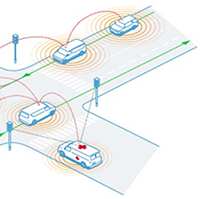|
 The European Strategy on Cooperative ITS—submitted by the European
Commission in November 2016, and reported in the March issue of IEEE
Vehicular Technology Magazine—also addresses technologies and
frequencies.
The European Strategy on Cooperative ITS—submitted by the European
Commission in November 2016, and reported in the March issue of IEEE
Vehicular Technology Magazine—also addresses technologies and
frequencies.
Cooperative intelligent transport systems (C-ITS)
messages will be transmitted for a wide range of services in various
transport situations and between different actors.
To receive all information on traffic and safety
conditions seamlessly across Europe, a hybrid communication approach is
envisioned, i.e., by combining complementary communication technologies.
To support all C-ITS services on the vehicle side, a full hybrid
communication mix needs to be on board.
On the infrastructure side, the choice of
communication technology depends on the location, type of service, and
cost efficiency. C-ITS messages should be unaware of the particular
communication technology used and thus flexible, easing the inclusion of
future technologies [e.g., fifth-generation (5G) and satellite
communication] into the hybrid communication mix.
At the moment, the commission is considering a
combination of ETSI ITS-G5 (the European version of IEEE 802.11p), and
existing cellular networks as the most promising hybrid communication
mix that ensures the best possible support for deploying all Day 1 C-ITS
services. It combines the benefits of ad hoc communications, implying no
need for access points and low latency of ETSI ITS-G5 for time-critical
safety-related C-ITS messages, with the wide geographical coverage and
access to large user groups of existing cellular networks.
In 2008, the commission designated a specific frequency
band for safety-related applications in Europe. ETSI ITS-G5 is based on
IEEE 802.11p, but using the European standardized messaging technology
and this specific frequency allocation available for ITS in Europe.
Initial deployment for short-range V2V and V2I communication will be
based on technologies already available using this band and will operate
in seamless coexistence with 5G where appropriate, under a
complementary principle.
To safeguard existing and future safety-related
applications from harmful interference, coexistence with applications
using adjacent bands or the same spectrum needs to be ensured. Adequate
mitigation techniques need to be defined and implemented (e.g., the
coexistence with tolling) and spectrum allocation should be assessed
carefully (e.g., the effect of the proposed radio local area network
extension into this frequency band).
The respondents to the public consultation gave
widespread support for the hybrid communication approach. For example,
less than 5% of respondents disagreed with the initial deployment based
on ETSI ITSG5, while the vast majority sees 5G as playing an important
role in the long-term. The following specific actions were also
identified.
- Road authorities, service providers, vehicle and radio equipment
manufacturers, and other industrial players should adopt a strategy for
hybrid communication in procurement and serial production to support the
full Day 1 C-ITS services list.
- Telecom operators that support C-ITS services should appropriately
manage the network load for road safety-related C-ITS services.
- The commission will maintain the designation of spectrum used by
ETSI ITS-G5 for safety-related ITS services and support measures to
protect this frequency band from harmful interference at European and
international levels (the United Nations International Telecommunication
Union and European Conference of Postal and Telecommunications
Administrations).
- C-ITS deployment initiatives should implement the relevant
mitigation techniques for coexistence according to ETSI standards and
procedures.
Full article: IEEE Vehicular Technology Magazine, Volume 12, Number 2, June 2017 |